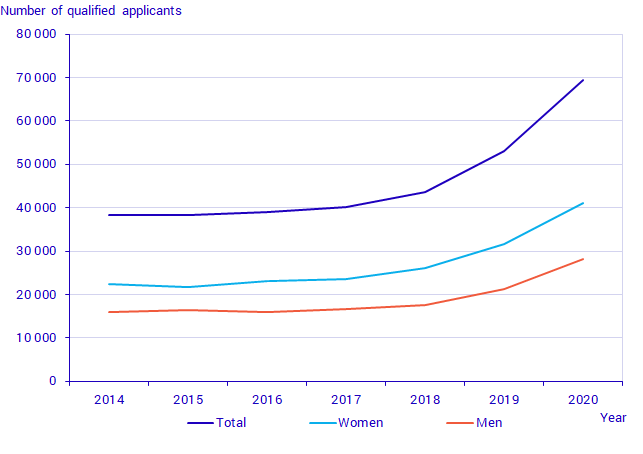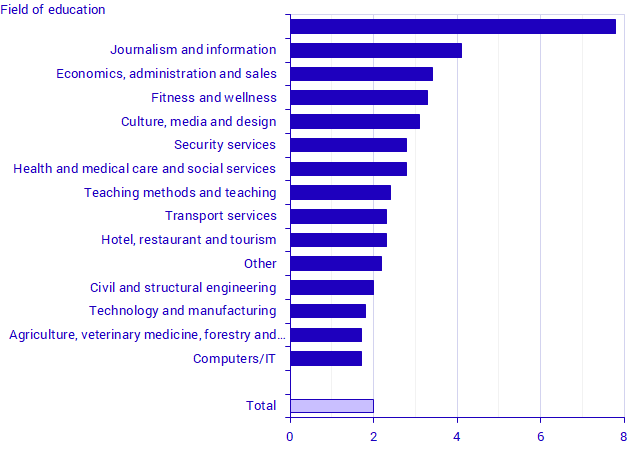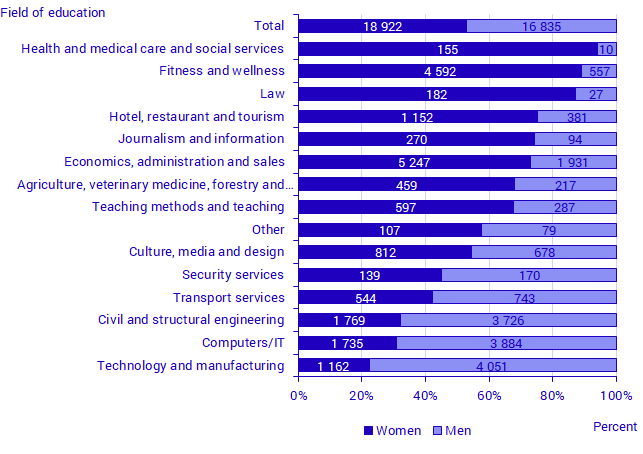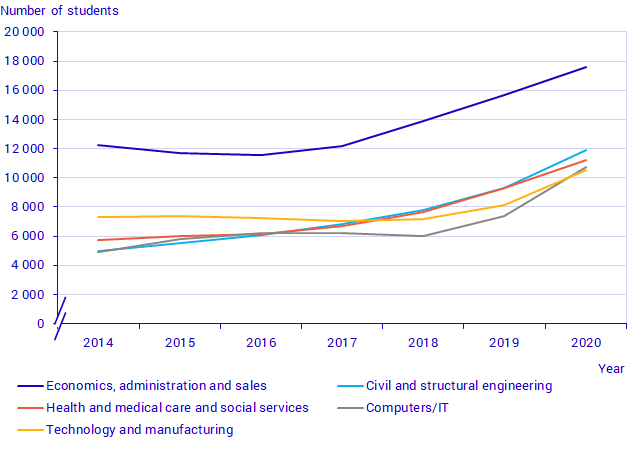Applicants and students in higher vocational education 2020
Higher vocational education continues to expand
Statistical news from Statistics Sweden 2021-03-26 9.30
The number of applicants to higher vocational education increased significantly in 2020. There were just over 69 400 qualified applicants, which is an increase of 31 percent. The number of admitted students who commenced their studies also increased, by 26 percent, to 35 800 admitted students. There were 77 900 students in higher vocational education in total.
The number of applicants to higher vocational education continued to increase. There were 69 400 qualified applicants to programmes starting in 2020, which is about 31 percent more than in the previous year. There were 2.0 qualified applicants for each place.

The number of applicants per place to higher vocational programmes varies between different fields of education. As in the previous year, the number of applicants per place was highest for programmes focused on law, and journalism and information. There are relatively few places in programmes in these fields and each represent about 1 percent of the total number of places in higher vocational education programmes that commences in 2020. The number of applicants was lowest to programmes in agriculture, animal care, forestry and fisheries and Computers/IT. There were 22 400 qualified applicants to economics, administration and sales, which was the overall largest field of education.

Sharp increase in the number of men who commenced studies
In 2020, there were 35 800 admitted students who commenced their studies, which is 26 percent more than in 2019. The number of men who commenced their studies increased by 31 percent and amounted to 16 800, and the number of women increased by 22 percent and amounted to 18 900. The share of women, which over time has been larger than the share of men, was 53 percent.
Proportion of women in Computers/IT increased
The highest number of admitted students who commenced their studies was in the field of education Economics, administration and sales, 7 200, of whom 73 percent were women. Computers/IT is now the second largest field of education, with 5 600 admitted students, of whom 69 percent are men. Women have increased their share here to 31 percent, compared with 27 percent in 2019.
The third largest field of education, Civil and structural engineering, had 5 500 students admitted, 68 percent of whom were men. Technology and manufacturing had 5 200 admitted students, 78 percent of whom were men. Health and medical care and social services had 5 100 students admitted, 89 percent of whom were women.

More women than men in distance learning
The proportion of students admitted in distance learning programmes increased from 27 percent to 31 percent. In total, there were 11 100 students admitted to distance learning programmes, compared with 24 600 to traditional programmes. Among women, 36 percent attended distance learning compared with men, for whom the corresponding share is 26 percent.
The fields of education with the largest share of distance learning were Security services at 71 percent, followed by Health and medical care and social services at 64 percent.
There are now 77 900 students
There were 77 900 students in higher vocational education in 2020. Among these, 54 percent were women, which is a decrease of 1 percentage point.
The five largest fields of education have increased their shares of students from 79 percent to 80 percent. The largest increase, 46 percent, was in Computers/IT. Technology and manufacturing increased by 29 percent, followed by 28 percent in Civil and structural engineering.

More women than men in short programmes
In 2020, a new concept was introduced in higher vocational education - short programmes in the form of courses and course packages. There were just under 7 100 qualified applicants to short programmes in higher vocational education.
Among the 5 300 students in 2020, 59 percent were women. Among women, the most popular field of education was Economics, administration and sales, followed by Health and medical care and social services. Among men, the most popular field of education was Civil and structural engineering, followed by Computers/IT.
The most common programme length was six weeks and most of the students studied Economics, administration and sales.
Distance learning as a form of education dominated the short programmes, at 84 percent.
The average age among students in short programmes was 39 years. The average age among women was slightly higher, 40 years, compared with 38 years on average among men.
Definitions and explanations
Official statistics on higher vocational education
Statistics Sweden has been responsible for official statistics on higher vocational education since 2018.
Statistics on applicants to higher vocational education are based on data that Statistics Sweden has collected from education providers since 2014. In the period 2014-2017, Statistics Sweden collected the survey data on behalf of the National Agency for Higher Vocational Education.
Statistics on students in higher vocational education are based on information from the Swedish National Agency for Higher Vocational Education, which in turn receives the information from the education providers. Higher vocational education is included in the statistics for 2007-2013.
Applicants
An applicant is defined by the following criteria:
- The applicant has submitted an application that includes information about the applicant's name and personal identity number (or name and date of birth).
- The applicant has submitted their application within the application period (within the ordinary or extended application period).
Net statistics of the number of applicants and the number of qualified applicants are presented. This means that once the number of applicants is reported, grouped by various education data, such as field of education or county, the number of unique applicants per study domain is counted. Persons who have applied to several study programmes in different study domains are counted once in each domain.
Admitted students who commenced their studies
The number of admitted students who commenced their studies refers to the number of persons studying three weeks after the study session began. Students who have been added during the course of the education and those who have dropped out are included. This means that all those who have been included in at least one register of students in a programme session are included.
Students
The number of students refers to active students in programme sessions that last at least one day during a specific period. An active student must be included in at least one study register during a specific period.
Persons who have been active students in several programmes during a specific period are counted once for each programme session.
Field of education
Field of education refers to the classification of programmes in the fields of education used by the Swedish National Agency for Higher Vocational Education (MYH). The fields of education are based on the SUN 2000 standard.
Short programmes
Short programmes refer to programmes that can consist of courses and course packages. The programmes should provide in-depth, renewed or broadened competency and can be up to six months long. See also the website of the Swedish National Agency for Higher Vocational Education for further information on short programmes. Information on applicants for and students attending short programmes is presented separately, that is, is not included in the regular higher vocational education statistics on long programmes lasting at least six months.
Next publishing will be
Statistics on graduates in 2020 are scheduled for publication in November 2021 together with updated information on applicants and students.
Statistical Database
More information is available in the Statistical Database
Feel free to use the facts from this statistical news but remember to state Source: Statistics Sweden.
